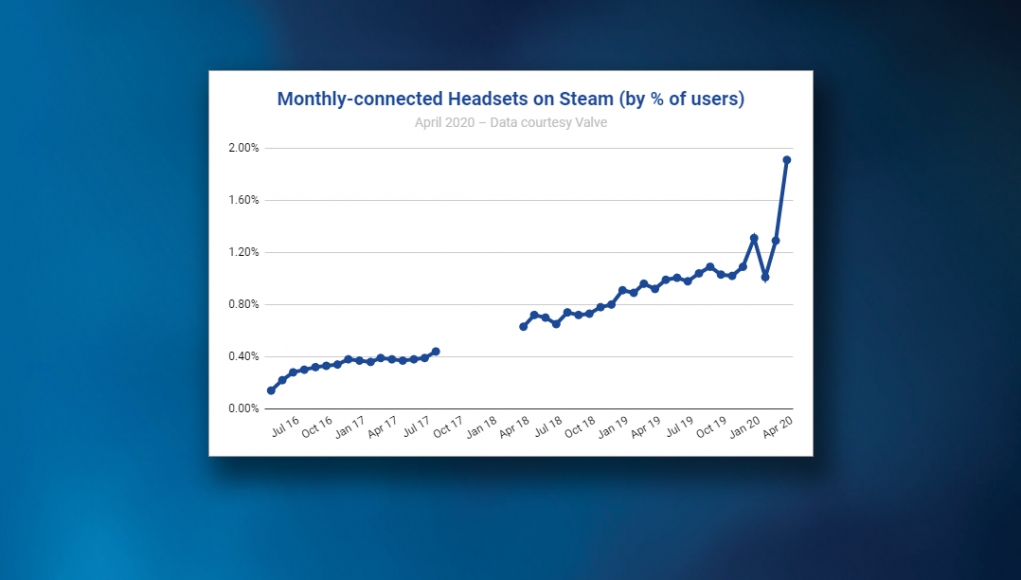The launch of Half-Life: Alyx saw nearly 1 million additional monthly-connected headsets over the prior month, a leap that nearly tripled the previous largest monthly gain.
Each month Valve collects info from Steam users to determine some baseline statistics about what kind of hardware and software is used by the platform’s population, and to see how things are changing over time, including the use of VR headsets.
The latest Steam Survey data is the first time we’re seeing the impact of Half-Life: Alyx in the numbers; although the game launched in late March, Valve advised that most survey data is collected early in each month, so the impact of the game’s launch wasn’t truly revealed until now. And it’s a doozy.
The data represents the number of headsets connected to Steam over a given month, so we call the resulting figure ‘monthly-connected headsets’ for clarity; it’s the closest official figure there is to “active VR users” on Steam, though it can’t account for headsets that were connected in a given month, but not used.
The launch of Half-Life: Alyx brought the single largest leap ever in monthly-connected headsets on Steam.
Monthly-connected VR Headsets on Steam
The latest figures from April show that 1.91% of Steam users had a VR headset connected to their PC over the course of the month. This is far and away the record high so far, and the largest single-month leap, nearly three times the prior record held by December–January during the 2019 holiday season.
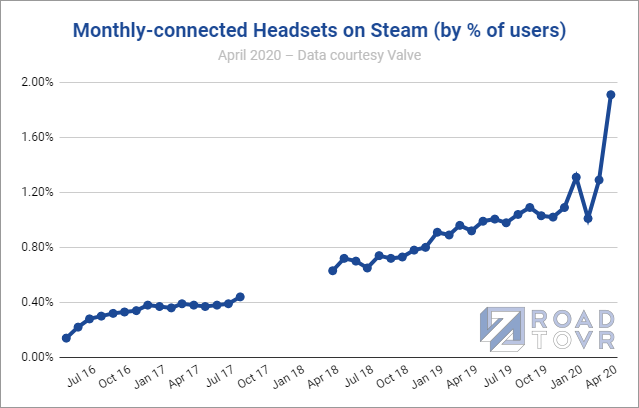 To put this into perspective, Steam users with connected VR headsets are now about twice as common as those using Linux, and about half as common as those using MacOS.
To put this into perspective, Steam users with connected VR headsets are now about twice as common as those using Linux, and about half as common as those using MacOS.
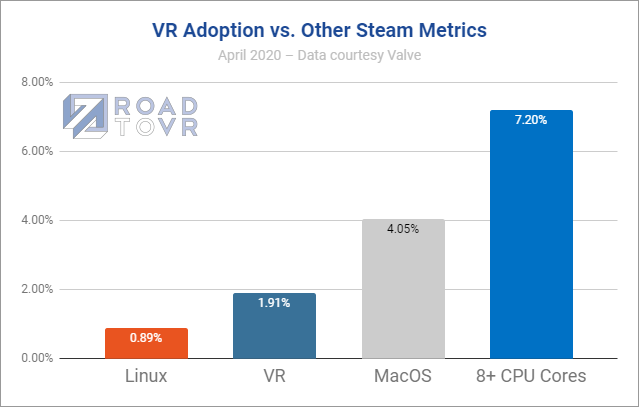 While Valve’s data is a useful way see which headsets are most popular on Steam, the trend of monthly-connected headsets has always been obfuscated because the data is given exclusively as percentages relative to Steam’s population—which itself is an unstated and constantly fluctuating figure.
While Valve’s data is a useful way see which headsets are most popular on Steam, the trend of monthly-connected headsets has always been obfuscated because the data is given exclusively as percentages relative to Steam’s population—which itself is an unstated and constantly fluctuating figure.
To demystify the data Road to VR maintains a model, based on the historical survey data, along with official data points directly from Valve and Steam, which aims to correct for Steam’s changing population to estimate the actual count—not the percent—of headsets being used on Steam.
From the model we estimate that April added nearly 950,000 monthly-connected VR headsets over the month prior, for a total of some 2.7 million headsets. That’s both the greatest total number and the largest single leap in the history of the data.
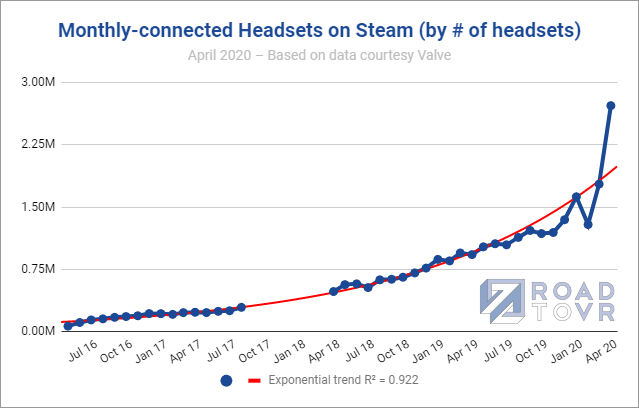 To be clear, the 950,000 headset gain is not necessarily new headsets. The breakdown between new headsets and those which were owned but not previously plugged in during the prior month is not known.
To be clear, the 950,000 headset gain is not necessarily new headsets. The breakdown between new headsets and those which were owned but not previously plugged in during the prior month is not known.
Of course it was expected that Half-Life Alyx would lead to a jump in the numbers, and this is huge jump. The big question is: how many of these extra monthly-connected headsets will stay around after the leap? We expect the next data point will dip compared to April, but will be interested to see what portion of the jump sticks longer term.
Share of VR Headsets on Steam
As for the share of individual headsets on Steam, the biggest winner in April was Oculus Quest. Though it’s a standalone headset, with the right cable it can optionally tether to a capable PC to work just like a PC VR headset. Clearly Half-Life: Alyx was a major reason for many Quest owners to get their headset up and running on Steam, leading Quest to leap to 6.03% (+3.14%) of the share of headsets on Steam.
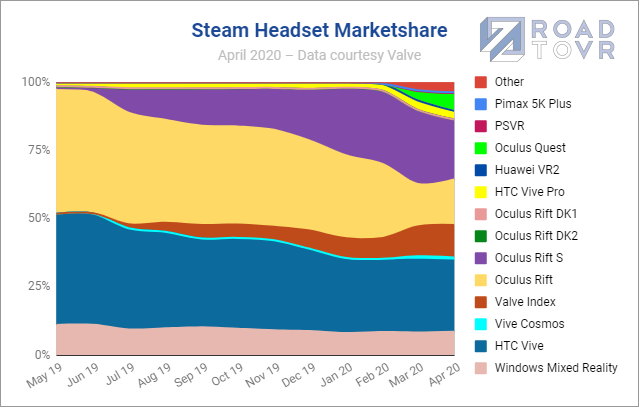 Curiously, Oculus’ latest PC headset, Rift S, fell to 21.95% (−5.08%) which is a sizeable change which suggests that a large share of Rift S users were already using SteamVR leaving less room for relative growth compared to older headsets like the original Rift at 16.60% (+1.04%) and WMR at 8.54% (+0.26%)—which would be more likely to be pulled out of the closet and dusted off for Half-Life: Alyx. Alternatively, the loss could also be related to Valve’s recent changes to the way the Survey collects data on VR headsets.
Curiously, Oculus’ latest PC headset, Rift S, fell to 21.95% (−5.08%) which is a sizeable change which suggests that a large share of Rift S users were already using SteamVR leaving less room for relative growth compared to older headsets like the original Rift at 16.60% (+1.04%) and WMR at 8.54% (+0.26%)—which would be more likely to be pulled out of the closet and dusted off for Half-Life: Alyx. Alternatively, the loss could also be related to Valve’s recent changes to the way the Survey collects data on VR headsets.
Speaking of Valve—the company’s Index headset hit 11.94% (+1.00%) in April, making Valve the third-largest vendor of headsets on Steam less than a year after the launch of the headset.
Howver, Oculus and HTC still dominate the share of headsets on Steam, with Valve and WMR further away in 3rd and 4th place.
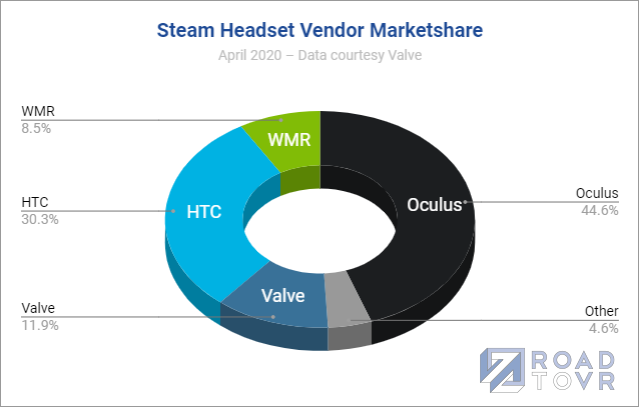 As ever, it’s worth noting that the Steam Survey only gives us a glimpse of the overall VR market, as it only counts headsets connected to Steam. That means it doesn’t count some portion of Rift users which may not use Steam at all, nor other major headsets like PlayStation VR on PS4 and Quest standalone.
As ever, it’s worth noting that the Steam Survey only gives us a glimpse of the overall VR market, as it only counts headsets connected to Steam. That means it doesn’t count some portion of Rift users which may not use Steam at all, nor other major headsets like PlayStation VR on PS4 and Quest standalone.

